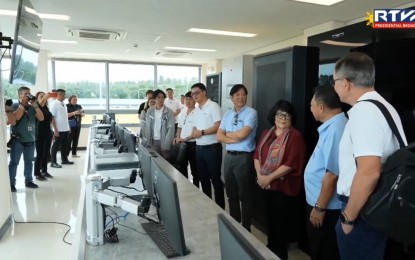
WATER IS LIFE. President Ferdinand R. Marcos Jr. (4th from right) leads the inauguration of the Davao City Bulk Water Supply Project at the Apo Agua’s water treatment facility in Davao City on Wednesday (Feb. 7, 2024). The Chief Executive also directed concerned government agencies to speed up the completion of all water-related projects in the country in preparation for the impact of the El Niño phenomenon. (Screengrab from RTVM)
MANILA – President Ferdinand R. Marcos Jr. on Wednesday directed concerned government agencies to speed up the completion of all water-related projects in the country.
Marcos issued the directive, as he warned that any disruption to the water supply could “degrade quality of life, dampen economic activity, and fuel disorder.”
“It is for this reason that I continually stress the urgency of improving water security, and directed agencies concerned to expedite the completion of all water projects across the country,” he said during the inauguration of the Davao City Bulk Water Supply Project at the Apo Agua’s water treatment facility in Davao City.
“Of all emergencies, water scarcity is the hardest to contain. It is, however, preventable with foresight, right plans, united action, and strong political will.”
Marcos in December last year ordered concerned government agencies to complete water-related projects by April 2024 in preparation for the impact of the El Niño phenomenon.
He emphasized the importance of contingency plans to avoid a potential water crisis.
He said the Davao City Bulk Water Supply Project is a “concrete step” to reduce reliance on limited groundwater by tapping the Tamugan River as a sustainable water source.
“This is very important as we have changed the policy and we are now starting to feel the effects of what we have been doing in the past,” the President said. “The Philippines is not a dry country and so this model that we are inaugurating here today is right in line with the shift in policy of government of taking water from surface water sources rather than from digging wells.”
The Davao City Bulk Water Supply Project has been operational in six areas since Dec. 1, 2023, supplying 300 million liters daily to more than 1 million Dabawenyos.
The public-private partnership (PPP) project between the Davao City Water District (DCWD) and Aboitiz InfraCapital’s water subsidiary Apo Agua Infrastructura, Inc. aims to distribute the treated water to DCWD’s reservoirs, creating an environmentally conscious and efficient water supply cycle.
The water treatment facility is powered by renewable energy sourced from its own run-of-river hydroelectric power plant.
Marcos hailed the “state-of-the-art” water treatment facility, which was designed based on the “water-energy nexus” model that allows raw water to first pass through the run-of-river hydroelectric power plant to generate energy and be used to produce treated water.
He said the project reduces dependence on the “already strained electricity grid” and “responds to clamor for better environment stewardship, more responsible management of natural resources.”
“So, let me take this opportunity to acknowledge the teams of Apo Agua and its parent company Aboitiz Infra Capital and the Davao City Water District and the local government of Davao City for the unwavering dedication that was required and to bring this project to fruition,” Marcos said.
“Your efforts to ensure the protection and conservation of Panigan-Tamugan Watershed and the management and rehabilitation of hundreds of hectares within the watershed areas show that we can pursue development without compromising the environment.” (PNA)
